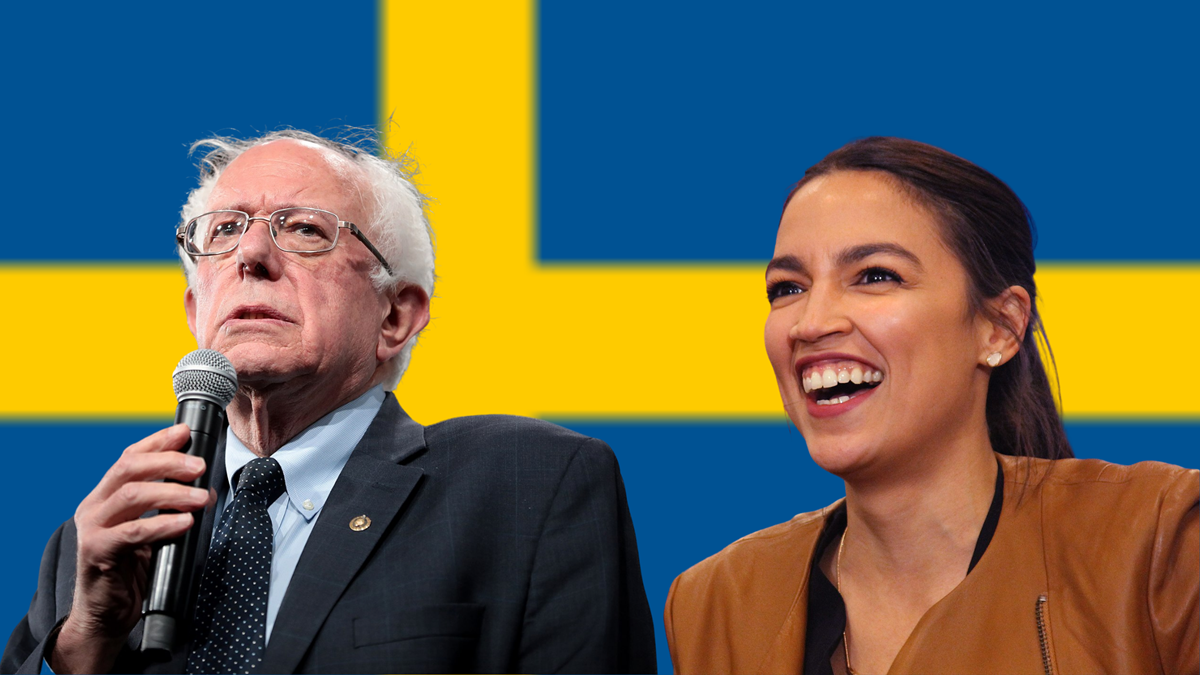Though the Democratic Socialists of America (DSA) was officially formed in 1982, the term “democratic socialism” really entered the popular lexicon in 2016 with Senator Bernie Sanders’s insurgent Democratic presidential campaign.
Many have struggled to understand the difference between “democratic socialism” and regular socialism since then. When questioned, leaders in the movement have predominantly pointed to the Scandinavian countries as a model.
Self-described “democratic socialist” Rep. Alexandria Ocasio-Cortez has said, “What we have in mind and what my policies most closely resemble are what we see in the UK, Norway, in Finland, in Sweden.” Sanders sticks to this talking point as well, frequently saying that the US should look to Sweden and other Scandinavian countries to learn from what they have accomplished for their working people.
But a closer look at the actual record of the Nordic countries reveals policies that look pretty different than those sought by Ocasio-Cortez, Sanders, and their ilk.
An Exorbitantly Expensive Welfare State
It is true that the Nordic governments offer government healthcare benefits, parental leave, childcare, and higher education for all citizens—but they pay dearly for it.
Democratic socialists in America propose trillions in public spending under the absurd notion that heavily taxing “the rich” alone can pay for their proposals. In reality, you could tax every “rich” person in America at 100 percent and still come up far short.
The 550 US billionaires together are worth $2.5 trillion. If we confiscated 100% of their wealth, we'd raise enough to run the federal government for less than 8 months.
— Antony Davies (@antonydavies) February 1, 2019
Perhaps our problem isn't how much billionaires have but how much politicians spend.@SenSanders @AOC
But Scandinavian countries are under no such delusion. They know that everyone pays for their welfare state.
According to US News and World Report, "the average Dane pays a total amount of 45 percent in income taxes." And per the Tax Foundation, "Sweden’s top marginal tax rate of 56.9 percent applies to all income over 1.5 times the average income in Sweden." (In the US, our top tax rate only applies at 9.3 times the average income).
These countries also impose extraordinarily high Value Added Taxes of 25 percent, with costs largely being passed onto consumers.
Personally, having this much of my income seized for the aforementioned benefits sounds like a horrible trade-off.
Furthermore, while tuition costs are covered for students in Scandinavia, the average student still carries $21,000 in debt when they graduate (only $10,000 less than the average American).
Remember, there are a lot of other expenses when it comes to college like room and board, textbooks, and other living expenses. In the US, students can at least choose cheaper options for themselves such as apprenticeships or community college, but in the Nordic model everyone is forced to pay for college via high taxes even if they don’t attend.
And while these countries were found to be the “happiest” in the world by one organization (whose evaluation standards are based on dubious measures), other reports have found this reputation actually masks a serious, growing epidemic of sadness and suffering, especially among the countries’ youth.
All in all, I find the Nordic model less than desirable. But let’s say you are still impressed by their system and wish to recreate it. It is important to observe the underlying policies that allowed the countries to generate enough wealth in order to then tax it and fund these programs.
For sake of space, I’ll hone in on Sweden’s approach.
Wealth Built, Then Squandered
First, it’s important to know that the Nordic countries were rich before they passed most of their big government programs. Sweden’s parliament actually passed a resolution in 1776 committing to free speech and affirmed free market measures thanks to the advocacy of classical liberal Anders Chydenius.
The next 100 years saw unprecedented wealth and growth as the country enjoyed laissez-faire reforms, deregulation of its financial markets, free trade, and competition. Then, during the next chapter of its history, Sweden sat out the two World Wars which bankrupted the economies of many other western countries. (An important reminder that if you want nice things, you need to adhere to a non-interventionist foreign policy.)
But as often happens when people become wealthy from capitalism, the country turned its back on the system that brought it so much prosperity and began dabbling in socialism in the 1960s and 1970s. A cradle-to-grave welfare state was created, tax rates increased, and regulation ran rampant.
It didn’t take long for these naive big-government policies to undo a century’s worth of prosperity.
By the 1990s the country was in freefall. Talent and businesses fled their tax burden, with IKEA leaving for the Netherlands and Tetra Pak (a major food packager) leaving for Switzerland. Sweden went from being the 4th richest member of the Organization for Economic Cooperation and Development (OECD) in 1970, to 13th in 1993. A financial crisis swept the country—unemployment sky-rocketed, gross domestic product bottomed out. Ultimately the government raised interest rates to 500 percent to avoid a devaluation of their currency.
The country’s Minister of Finance, Olof Feldt, remarked, “That whole thing with democratic socialism was absolutely impossible. It just didn’t work. There was no other way to go than market reform.”
Bernie Sanders and Ocasio-Cortez need to get up to speed.
Turning Back Toward Capitalism
In the late 1990s and early 2000s, Sweden sold its state-owned companies, deregulated its financial markets (again), and replaced public monopolies with competition. Top tax rates were cut, welfare programs were reformed. And they went even further.
The truth is, if we wanted to study what Sweden has done and replicate it, our focus should be on freer trade, a deregulated product market, ending Fannie Mae and Freddie Mac, the abolition of occupational licensing and minimum wage laws, the elimination of property, gift, and inheritance taxes, a reduction in our corporate tax rate, privatization of Social Security, comprehensive school choice, and a rejection of lockdowns.
These sound more like the policies libertarians call for, and nothing like the ideas championed by the DSA, Sanders, or Ocasio-Cortez. All in all, the success of the Nordic countries is largely owed to free-market capitalism. It is only because of their laissez-faire approach that Sweden can afford their large welfare programs in the first place.
Interestingly, the supposedly “socialist” Nordic countries consistently rank at the top of various economic freedom indexes. As one example, Denmark currently ranks 8th on the Heritage Foundations’ list and Iceland is at number 13, while the US falls to number 17. Finland comes in shortly behind us at position 20, and Sweden at 22.
Is it possible the leaders of the democratic socialists are this uninformed? Doubtful.
In reality, they are grasping at straws, because the true examples of where their policies are actually in place—like Venezuela, Cuba, or North Korea—are terrifying. People are going hungry, they can’t get basic medicines, and the ruling class enriches itself as its people suffer miserably.
Fortunately, for now, the majority of Americans see through this ruse and continue to view socialism poorly. There’s no question that democratic socialism is really just a new(er) term for a very old idea that has never worked.
From Ocasio-Cortez to Sanders, supporters of “democratic socialism” argue it has never been truly implemented. But every time it has been tried it has led to destitution, despotism, and death. Free-market capitalism, to the imperfect extent it has ever been implemented, has led to prosperity, longer-life, and better living conditions.
It’s clear which one we should keep striving for.

